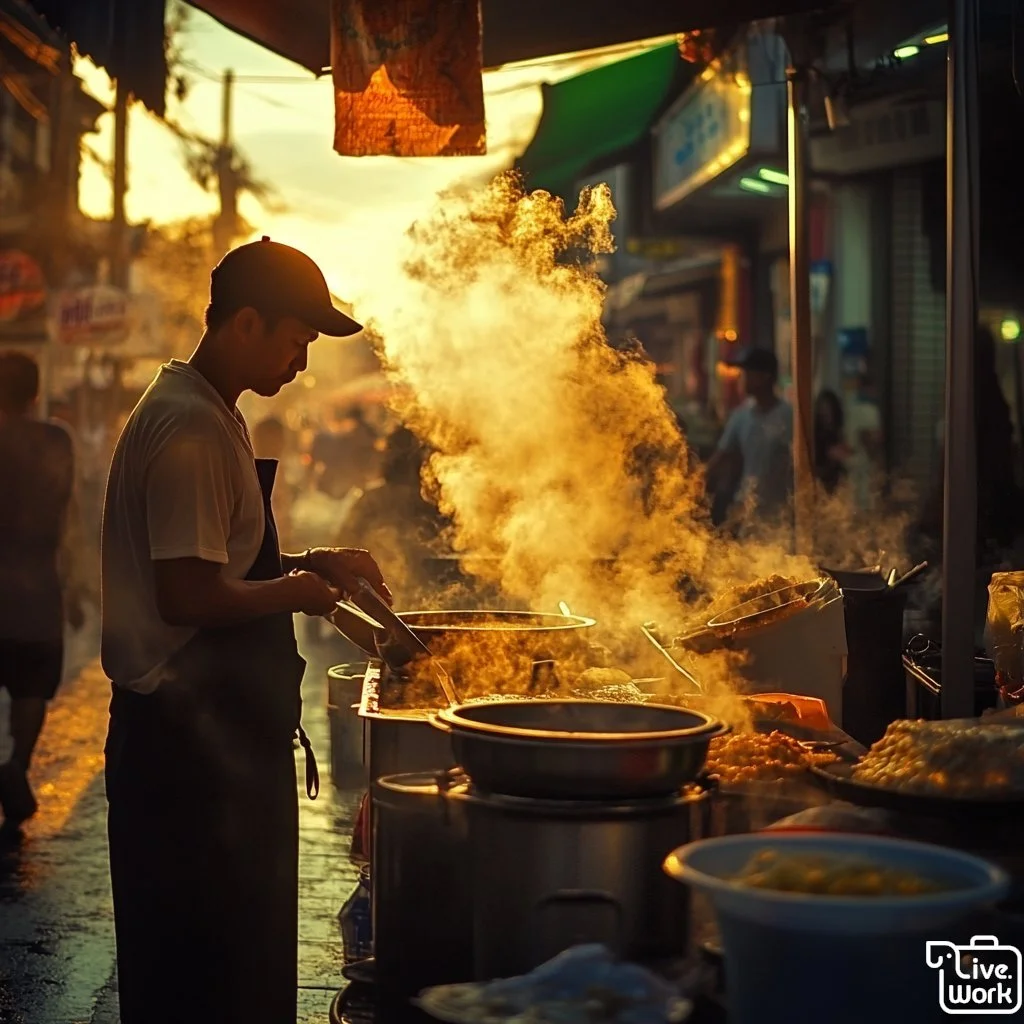Thailand’s Street Food: A Flavorful Journey Through Culture and Community
If you want to understand Thailand, start by following your nose. The sizzle of woks, the snap of grilled satay skewers, the comforting steam of noodle soups—Thai street food is not just a culinary experience; it’s a living expression of tradition, creativity, and community.
Every alleyway, night market, and roadside stall across Thailand offers more than just food. It offers a connection to the country’s soul—where history, innovation, and daily life converge on a single plate.
🍜 Why Thai Street Food Is World-Famous
Thailand’s street food is celebrated around the world for its:
Explosive flavors—spicy, sour, salty, sweet, and umami often combined in one bite.
Regional diversity—each province brings its own culinary flair, from Isaan’s fermented sausages to the coconut-rich dishes of the South.
Accessibility—delicious meals can be enjoyed for just 30–60 THB ($1–$2).
Fresh ingredients—markets offer produce picked that very morning, prepared with skill and speed.
But beyond the food itself, street dining in Thailand represents a social ritual and a democratic dining experience—where students, families, and tourists eat elbow-to-elbow in a celebration of flavor and connection.
🌆 Where to Eat: Top Street Food Spots Across Thailand
Bangkok
Yaowarat (Chinatown): A sensory overload of seafood stalls, dessert carts, and legendary noodle joints.
Victory Monument: Popular for boat noodles (kuay teow rua) and late-night snacks.
Ratchada Train Night Market: A modern take on the night market with rows of open-air food vendors.
Chiang Mai
Sunday Walking Street: Home to grilled meats, coconut pancakes, and northern specialties.
Chang Phuak Gate Night Market: Known for “Cowgirl Hat Lady” and her rich khao kha moo (braised pork leg on rice).
Phuket
Old Town Weekend Market: Try southern Thai dishes like moo hong (pork stew) and crispy fried chicken with sticky rice.
Lock Tien food court: A blend of Thai and Peranakan (Straits Chinese) flavors.
Isaan (Northeastern Thailand)
Expect bold, fiery dishes like som tam (papaya salad), larb (minced meat salad), and kai yang (grilled chicken)—often enjoyed with sticky rice and a cold drink.
🍲 Must-Try Thai Street Food Dishes
Here’s a guide to some of Thailand’s most iconic and beloved street food:
| Dish | Description |
|---|---|
| Pad Thai | Stir-fried rice noodles with shrimp or chicken, peanuts, tamarind, and lime. A perfect balance of sweet, sour, and savory. |
| Tom Yum Goong | Spicy-sour shrimp soup with lemongrass, lime leaves, galangal, and chili. Intensely aromatic and warming. |
| Som Tam | Green papaya salad pounded with chili, lime, fish sauce, and peanuts. A staple of Isaan cuisine. |
| Moo Ping | Grilled pork skewers marinated in garlic, soy sauce, and palm sugar. Typically eaten with sticky rice. |
| Khao Niao Mamuang | Sweet sticky rice with ripe mango and coconut cream. A beloved Thai dessert. |
| Roti | Thai-style pancake with condensed milk, banana, or egg, often made to order on sizzling griddles. |
| Satay | Skewered grilled meat, usually served with rich peanut sauce and a tangy cucumber relish. |
🧠 What Street Food Tells Us About Thai Culture
Respect for balance: Thai cuisine is built on harmony—every bite should awaken multiple taste receptors.
Adaptability and creativity: Vendors innovate constantly, adapting dishes to trends, dietary needs, and available ingredients.
Community spirit: Food stalls are meeting points—meals are rarely eaten alone and are often shared.
Economic inclusivity: Whether you’re on a budget or indulging, you’ll find satisfaction on any street corner.
Eating street food is a portal into how Thai people live, celebrate, and sustain their communities.
💡 Tips for First-Time Street Food Explorers
Follow the locals: Busy stalls usually mean fresher ingredients and higher turnover.
Watch food preparation: A good vendor will prepare your food fresh and in front of you.
Mind the spice: Dishes like som tam or tom yum can be very hot—ask for “mai pet” (not spicy) if needed.
Bring cash: Most vendors don’t accept cards.
Don’t skip the condiments: Lime juice, fish sauce, sugar, chili flakes—season to your taste like a local.
🌍 Street Food as Culinary Heritage
UNESCO recognizes Thailand’s culinary practices as part of its intangible cultural heritage. Thai street food isn’t just food—it’s ritual, innovation, performance, and survival.
And as the country modernizes, efforts to preserve this culinary ecosystem are ongoing—through documentation, street vendor associations, and tourism initiatives that respect and elevate Thailand’s street-side chefs.
Final Thoughts: A Feast for the Senses and the Soul
To eat Thai street food is to taste history, community, and joy. Each stall is a stage, each dish a tradition, and each bite a memory in the making. Whether you’re indulging in crispy spring rolls, sipping hot noodle broth, or discovering a dessert you can’t name but won’t forget—you’re not just eating. You’re experiencing Thailand’s living, breathing food culture.
